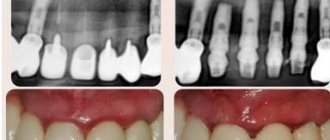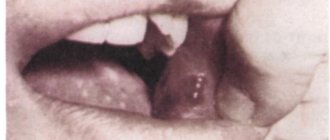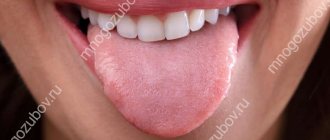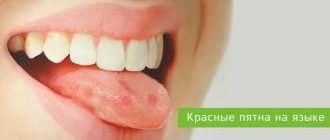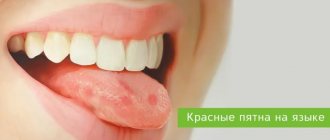The tongue is a muscular organ that responds to the occurrence of any pathologies in the human body by changing color, the appearance of plaque, ulcers, and fluid-filled cavities. A number of formations and minor irritations can disappear without the use of medications, with the help of rinses and compresses. Blisters on the tongue can provoke the development of serious diseases , so their treatment requires mandatory medical consultation.
Signs of normality and pathology
The tongue is a muscular organ that is responsible not only for our speech and perception of the taste of food, but also often signals problems occurring in the body. In its normal state it is pinkish, the tissue structure is homogeneous. The organ can be covered with a whitish coating (most often in the morning), or colored deposits from food: both types are easily removed with a brush or scraper.
In normal condition, the tongue is pinkish
If spots and blisters of different colors and in different quantities appear on the tongue, this indicates a negative impact on the tissue of external factors, or the occurrence of pathological processes and various diseases in the body1. In this case, the neoplasms can itch, burn, hurt, itch, burst, become covered with a crust and a foul-smelling coating.
We will analyze all the main reasons further.
Dental problems
Wondering how blisters on the tongue are related to dental pathologies? Incorrect bite, the presence of chipped and damaged teeth, poorly fitted orthopedic and orthodontic structures can lead to periodic and systematic injury to the muscular organ and its biting. In most cases, after an injury, a single blister forms on the tongue, which, depending on the depth and severity of the injury, sometimes becomes filled with blood.
In fact, dental pathologies most often lead to tongue injuries in adults, when red, bleeding wounds and blisters appear on the tissue. But in children, the appearance of rashes on a muscle organ is often caused by a restless lifestyle: while playing, children fall, hit themselves, and can bite their tongue until it bleeds.
After an injury, a blister may form on the tongue, which is sometimes filled with blood.
Sometimes it’s not a traumatic factor at all. Formations on the tongue can appear under the influence of pathogenic bacteria that live in plaque, which is abundantly deposited on the surface of the teeth and gums. This happens if a person does poor oral hygiene and only for show, does not treat in a timely manner and causes caries, pulpitis, gingivitis, and periodontitis.
“One time I began to notice that some kind of bubble with blood inside came out on my tongue. It looked like something had damaged the tissue. I went to the dentist, he said: yes, there are problems in my mouth. I corrected all the flaws and restored some of my teeth. But this infection did not go away, but seemed to begin to grow even more. Then, reluctantly, I went to a therapist, who, after an examination, urgently sent me to an oncologist. He diagnosed him with hemangioma. It’s good that this infection turned out to be benign, it was removed, and the prognosis is favorable. Doctors said it could have been caused by simply biting the tongue while the teeth were in poor condition, even before going to the dentist.”
Evi, review from woman.ru
Thermal and chemical burns
Pathology may indicate that a person has consumed too hot foods and drinks. The problem often occurs among smokers, as cigarette smoke can lead to irritation and damage to delicate tissues.
A burn can be caused by eating sour and spicy foods, after which a feeling of “on edge” often appears on the tongue. The problem is also caused by the independent use of various drugs, as well as aggressive agents in folk recipes for the treatment of diseases of the oral cavity (hydrogen peroxide, iodine, potassium permanganate, garlic, alcohol).
A blister may occur as a result of a burn.
As a rule, in such situations, the very tip of the tongue becomes blistered.
"Chlorhexidine": instructions for use for mouth rinse
This is a cheap and universal antiseptic. Bottle with 100 gr. The product costs about twenty rubles. You can buy it at any pharmacy without a doctor's prescription. True, pharmacists often offer Miramistin, which is more expensive, but do not fall for the assurances that the effect of these solutions is completely identical. They differ from each other only in cost.
Instructions for use for “Chlorhexidine” for mouth rinse indicate that the drug has the following properties:
- stopping the development of infection;
- reducing the activity of pathogenic microorganisms;
- pain relief after tooth extraction;
- disinfection of the oral cavity;
- healing of pimples, inflammations, ulcers;
- acceleration of healing after damage to the tongue, gums, cheeks;
- treatment of sore throat and inflammation of the lymph nodes;
- reduction of swelling;
- accelerated tissue healing after oral surgery;
- reduction of hyperemia.
To rinse, dilute the concentrated preparation in a ratio of 1:5 with clean water. The first rinse should be a test: if the child does not experience excessive burning, then the procedure can be continued. Otherwise, the solution should be diluted by another third.
Candidal stomatitis
Many are accustomed to thinking that stomatitis caused by the Candida fungus virus makes itself felt only through ulcers and rashes that appear on the gums and palate. But in fact, its main symptom is a dense whitish or grayish coating of curd consistency on the tongue. If you try to remove such plaque, you will find blisters underneath that itch, hurt, and bleed. As a rule, small blisters are found around the perimeter of the tongue.
The photo shows candidal stomatitis
Often the disease is provoked not only by weakened immunity, dysbiosis and long-term use of antibiotics, but also by the presence of advanced dental pathologies and lack of proper oral hygiene.
Herpes virus
A scattering of small blisters on the tongue (in any area) can also signal the development of a herpetic infection. In this case, the neoplasms look like transparent blisters filled with fluid or pus. A few days after their appearance, such blisters burst, and their contents enter the oral cavity and contribute to the spread of infection to healthy tissues. Very painful ulcers appear at the site of the formations, causing discomfort while eating food.
Pathology may be herpes
To cure blisters on a child's tongue
In order to eliminate bubbles on a child’s tongue that have formed due to dysbiosis, it is first necessary to undergo treatment aimed at restoring full intestinal functions. If this is a small child, then first you need to deal with nutrition. For example, you can add white cabbage to the cutlets, previously minced through a meat grinder. Cabbage plays the role of a “broom” and removes all harmful elements from the children’s intestines.
If we are talking about the digestion process of infants, then the mother should reconsider her diet. Treatment of blisters can be carried out only after consultation with a doctor. The specialist will select the drug that will not harm the baby.
Allergic dermatitis
When small blisters appear at the root of the tongue, they are red in color and itch very much, this usually indicates the development of an allergic reaction to food, personal hygiene products (inappropriate brush, mouthwash), and medications.
The photo shows an allergy on the root of the tongue
In such conditions, the muscular organ swells, and the lymph nodes become slightly swollen. In advanced stages, cracks, crusts and erosions can form, and rashes can appear not only in the mouth, but also around the lips and even on the face.
Treatment of blisters on a child's tongue
Blisters that appear on a child’s tongue require mandatory examination in a medical facility.
Initial treatment at home should include:
- rinsing with antiseptic solutions;
- the use of local antiherpetic liniments (Acyclovir, Viferon), aloe juice.
Lubricate the inflamed mucous membrane with the indicated medications every 8 hours.
If the problem is not resolved after 2-3 days, then you should go to the hospital or call a pediatrician at home.
A minor inflammatory process on a child’s tongue can be cured with the help of medicinal herbs.
Therapy with folk remedies in pediatrics is allowed within reasonable limits. Before using medicinal decoctions, you must make sure that the baby does not have any individual intolerance to the components of the medicinal composition.
For sore throat, warm compresses can be applied to the throat area (in small doses).
If, despite following all medical recommendations, the child continues to get sick, an elevated temperature appears, and the plaque on the root of the tongue thickens, then hospitalization of the little patient is indicated.
Upper respiratory tract diseases
If red round blisters appear on the tongue closer to the throat, the throat itself swells, itches and becomes inflamed, the body temperature begins to rise, the breath becomes foul, and the person cannot eat without pain, then based on these symptoms one can suspect a sore throat and pharyngitis. With pharyngitis, the voice “sits down” and it becomes very difficult to talk.
Throat diseases can cause pathology
A similar symptom is recorded in the following conditions: syphilis, tuberculosis, HIV, oncology, vitamin deficiency, diabetes mellitus, pemphigus, angisarcoma.
First aid
Blisters on the tongue cannot be ignored. If a rash is detected, you must contact a medical facility for examination and consultation with a doctor.
If it is not possible to visit a therapist, then to alleviate the patient’s condition, it is recommended to take the following measures:
- Rinse . The use of antiseptics Miramistin and Chlorhexidine is allowed. It is possible to disinfect neoplasms that appear on the root of the muscular organ with Furacilin solution. It is also recommended to rinse your mouth with decoctions of medicinal herbs (calendula, chamomile). The frequency of procedures is at least 3-4 times a day. A blister on the tongue (both on the body of the muscular organ and near the throat) is treated with concentrated solutions of soda or a mixture of soda and salt.
- Use of an antifungal drug . Blisters found on the tongue during candidal stomatitis are advised to be treated by using the medication Nystatin.
- Use of painkillers .
Dentists recommend regularly cleaning the surface of the oral cavity from accumulated plaque using a special tool (scraper). At the end of the manipulation, it is necessary to thoroughly massage the body of the tongue with a soft-bristled toothbrush.
Additional ways to reduce pain and irritation of the mucous membranes in the presence of small white blisters are complete abandonment of bad habits and a strict diet.
Traditional medicine recommends treating red blisters with infusions of sage and oak bark.
After removing the acute symptoms of the disease and alleviating the general condition of the patient, you should contact a medical clinic specialist who will advise the necessary treatment regimen, taking into account the severity of the disease and the frequency of exacerbations.
Infectious pathologies
Almost all children aged 3-7 years get chickenpox, during which you can easily find blisters not only on the body, but also in the mouth, usually located at the root of the tongue, as well as rashes closer to the throat, filled with a yellowish liquid. The disease can in rare cases be found in adults, but the older generation suffers it much more severely, almost always with high body temperature and severe malaise.
With chickenpox, pimples can be not only on the body, but also on the tongue
There is another childhood pathology - scarlet fever. This disease manifests itself in almost the same way as chickenpox, but it also causes swelling of the larynx.
How you can help yourself and others
So, you or your child have blisters on the root of the tongue, closer to the throat, or in other areas of the muscle organ. Confused about what this means and how to proceed? We'll tell you.
Don't leave the problem unattended
First, identify the accompanying symptoms. If the pathology is accompanied by an increase in body temperature, severe pain, inability to eat food, or general weakness, then you need to call a general practitioner. If there is no fever and the blisters persist for longer than 2-5 days, it is important to visit a specialist yourself. If the rashes are systematic (if they are not one-time, but appear at certain intervals again and again), it is better to visit the dentist, because often the problem indicates an incorrect bite and others dental pathologies.
Until you have consulted a doctor, be sure to treat damaged tissue
You can use classic and, most importantly, time-tested disinfectants: “Chlorhexidine”, “Furacilin”. For this purpose, children and pregnant women are recommended to use Miramistin, a decoction of chamomile, and a soda solution is also suitable. This will help relieve inflammation and soreness, reduce the risk of infection and spread to healthy tissue, and speed up the healing process.
Rinsing with disinfectants will help in treatment
If a muscle organ is sore, it is allowed to take painkillers and non-steroidal anti-inflammatory drugs from a home medicine cabinet. For example, Nurofen, Ibuprofen.
You can not only rinse your mouth with the products listed, but also treat the inflamed area with sprays like Hexoral, Tantum Verde, and Lugol. Especially if the blisters are located closer to the throat. The listed drugs will not only help relieve inflammation, but will also have an analgesic effect.
It is important to thoroughly clean the oral cavity and the tongue itself due to plaque
By removing food debris from your mouth, you deprive pathogenic bacteria of a favorable environment for reproduction and thereby reduce the likelihood of developing complications. But the effect on the muscular organ must be gentle and careful. You should not rub or scrape your tongue or actively press on it, as this can cause irritation and damage the tissue even more.
Don't brush your tongue too hard or too thoroughly
Under no circumstances should you touch the rash with your hands or foreign objects, comb it, or try to open it or squeeze it out yourself.
It is necessary to exclude some dishes and drinks from the menu
Pain and itching can become even worse if you consume citrus fruits, salty foods and spicy seasonings, excessively hot and carbonated drinks, whole hard vegetables and fruits.
During the period until the disease has completely subsided, it is recommended to drink plenty of fluids, which helps to increase the production of saliva, which is an excellent natural antiseptic.
Stop using common things
This should be done if you suspect viral or fungal diseases that cause blisters on the tongue. Otherwise, your loved ones and those closest to you, with whom you share a towel, dishes, cosmetics, and cutlery, may contract the infection.
Remember that you can only talk about home treatment for a blister if it is not a specific symptom of one of the diseases.
Notice
: Undefined variable: post_id in
/home/c/ch75405/public_html/wp-content/themes/UltraSmile/single-item.php
on line
45 Notice
: Undefined variable: full in
/home/c/ch75405/public_html/wp-content /themes/UltraSmile/single-item.php
on line
46
Rate this article:
( 5 ratings, average: 4.20 out of 5)
language
- Lutskaya I.K. Systematic and independent diseases of the tongue. // Medical news. – 2015.
Expert “To eliminate the factor that causes the appearance of traumatic blisters on the mucous membrane of the tongue, the patient may have to undergo orthodontic treatment, think about prosthetics or replacing old structures with new ones, and restore teeth using different restoration methods. It is also very important to perform professional oral hygiene and treat teeth and gums, since various pathogens from plaque and advanced diseases can aggravate the situation and provoke an inflammatory process.” Dental hygienist Victoria Nikolaevna Kashaeva
Consulting specialist
Tarabanovskaya Marina Igorevna
Specialization: Dentist therapist, periodontist Experience: 10 years
How to carry out treatment
In order to determine the treatment strategy for blisters, it is necessary to determine their location on the tongue. If there are blisters on the surface of which there is plaque, it is necessary to use oxolinic ointment.
Before carrying out therapy, you must contact a dentist, who will correctly diagnose and select the necessary medications.
Initially, treatment for blisters is carried out with the use of antihistamines. Their production can be carried out in the form of tablets.
The required dose of the tablet must be ground into powder and given to the child. It is allowed to drink it only with clean water. After this, the use of Holisap is recommended. This spray ensures the fastest healing of blisters.
If the disease occurs against the background of a viral infection, then children are given drugs whose action is aimed at suppressing them. If a child has chickenpox, then nothing needs to be done.
A small patient needs constant disinfection of the oral cavity, which will eliminate the possibility of bacterial growth. For this purpose, aloe juice is used, which must first be diluted with water.
It is given to the child in small quantities.
This set of actions must be performed, regardless of the causes of the pathology. The only distinguishing aspect is the use of certain drugs.
Treatment according to location
The selection of a specific treatment method should be carried out depending on the location. If neoplasms appear on the tongue, this indicates the development of:
- Chickenpox;
- Pharyngitis;
- Scarlet fever.
During the course of these diseases, in most cases the body temperature rises. If a child has candidiasis, then the blisters are also on the tongue.
They are characterized by the presence of a white coating on the surface, which can be removed. With stomatitis, plaque cannot be removed. When you try to eliminate it, bleeding will occur.
Blisters should be treated according to the cause of their appearance. That is why it must be prescribed by a specialist.
Traditional and folk medicines
Treatment of blisters on the tongue in children can be carried out using traditional medicines or traditional medicine. Among pharmaceutical drugs, sprays and gels are quite effective.
With their help, the pathogenic environment is removed. To ensure the most effective healing of blisters, the use of Holisap and Chlorophyllipt is recommended.
In parallel, the child is prescribed other drugs, the action of which is aimed at eliminating the cause of the appearance of this symptom. To eliminate rashes, special patches can be used that have an anti-burn effect.
Treatment with these drugs is permitted only if the child is over five years old. To eliminate the manifestations, it is recommended to use oxolinic ointment, which is the most effective and safe.
In order to eliminate fungal infections, children are prescribed Nystatin ointment.
Traditional medicine has a high effect in the treatment of blisters. In most cases, therapy is carried out using decoctions of beneficial herbs.
To prepare the medicine, you need to take chamomile flowers and the ground part of sage and mix in equal quantities, add water and boil for 10 minutes. After this, the decoction must be left for an hour.
Blisters can be caused by stomatitis, this is discussed in this video:
It is recommended that the child take it orally. If the baby is 4 years old, then he should be given no more than two tablespoons of medicine per day. Every year the dosage of the folk remedy increases by half a tablespoon.
Therapy for blisters on the tongue in children can also be carried out using aloe or Kalanchoe. With the help of the first flower, the fastest healing of wounds that form at the site of the vesicles is ensured.
One leaf of the old plant must be washed and skinned. Next, the juice is squeezed out of the flower and mixed with water. It is recommended to rinse the mouth with the help of the medicine.
This medication is also approved for oral administration.
The daily dose of the medicine should be no more than one tablespoon. Before swallowing the folk remedy, the child should be advised to hold it in his mouth. The longer he does this, the better.
If there is no aloe flower in the house, it can be replaced with Kalanchoe. During the treatment of pathology with traditional medicines, in order to avoid undesirable effects, it is recommended to take into account contraindications.
Despite the fact that traditional medicine is safe, before using any of them, you should consult a doctor.
Comments
A pimple appeared on my tongue and it was very itchy. Maybe I should drink something for my allergies? Or go straight to antibiotics?
Maria (12/11/2020 at 12:18 pm) Reply to comment
- If you suspect an allergy, it is still permissible to take an antihistamine (Erius, Zodak, Suprastin). But antibiotics, antifungal and antiviral tablets should never be used without the prescription of a specialist. Although the symptoms of conditions that cause blisters on the base of the tongue or closer to the throat are similar, each is treated differently. So, if you start taking antifungal medications for a herpetic infection, you can further aggravate the situation.
Editorial staff of the portal UltraSmile.ru (12/16/2020 at 09:12) Reply to comment
It’s good if the dentist paid attention to the pathology and advised you to see a therapist. Can a dentist, seeing a problem, recommend donating blood for specific types of diseases?
Dasha (12/18/2020 at 10:00) Reply to comment
Herpes is half the problem, or if you suddenly and carelessly sip hot tea or boiling water. How do you get these blisters out? Firstly, the tongue hurts and eating will be uncomfortable and painful.
Yura (12/18/2020 at 11:38 am) Reply to comment
If there is a minor allergy that causes blisters on the tongue, does it make sense to choose antihistamines? I have noticed this phenomenon in myself more than once, it slowly goes away.
Ruslan (12/18/2020 at 11:42 am) Reply to comment
I recently changed my toothpaste and noticed a rash on my tongue. Could they be a reaction to toothpaste? Please advise what to do in this case, maybe not to risk it and replace it with another?
Lena (12/18/2020 at 11:44 am) Reply to comment
Should you go to an ambulance with this problem? Maybe the doctor will advise something, prescribe some medications? Is it really possible to self-medicate if such a problem suddenly arises?
Masha (12/18/2020 at 11:45 am) Reply to comment
Not long ago I took ice cream out of the freezer, ate it and noticed that blisters appeared on my tongue after eating it. Is this a reaction to dyes and composition or an allergy to cold, tell me how to find out?
Leonid (12/18/2020 at 11:46 am) Reply to comment
Blisters periodically appear on the child’s tongue, but just as mysteriously they go away on their own. After a while this repeats itself. Tell me, could this be due to problems with the gastrointestinal tract?
Anna (02/05/2021 at 09:33) Reply to comment
Wow, there are so many reasons, you won’t immediately understand why, in any case you need to go to a specialist, and you probably won’t figure it out without tests. And if they appear and disappear on their own, is it worth going to the doctor?
Alena (02/05/2021 at 10:01 am) Reply to comment
Sometimes small blisters or pimples appear on the very tip of my tongue, I don’t know what they’re called exactly. They cause slight discomfort, but gradually disappear. There seem to be no health problems. What could it be? Do I need to go to a specialist about this?
Ekaterina (02/05/2021 at 10:03 am) Reply to comment
Tell me, a couple of days ago, my tongue started to burn, as if it had been burned by boiling water, today I noticed small blisters, is this an allergy to something?
Valeria (06/08/2021 at 19:37) Reply to comment
Write your comment Cancel reply
Why do they appear?
As already mentioned, there are no sebaceous glands on the tongue, so “pimples” cannot appear on it in principle. After all, a pimple is an inflammation of the sebaceous gland. But the bumps and nodules that sometimes appear on the surface are very similar in appearance to pimples, which is why they got that name. Pimples under the tongue or on the tip cause a lot of trouble and are extremely painful. Let's consider the reasons for their appearance.
Mechanical damage
Often, in the process of chewing or biting food, we bite our tongue, resulting in a slight mechanical injury. The risk of surface damage increases when consuming hard foods with sharp edges (crackers, chips, seeds). A small painful swelling or bump forms at the site of the injury, which after some time turns into a white pimple. The pain intensifies while eating. With severe mechanical damage, slight swelling may occur.
You should exclude spicy and hot foods from your diet, carefully monitor oral hygiene, and after a few days the pimple will disappear on its own.
Allergic reaction
The appearance of pimples on the tongue may indicate an allergic reaction to food, medicine or toothpaste. In this case, small white pimples and sores form, which hurt and irritate when eating or drinking liquid.
If your doctor suspects an allergy, it is very important to identify the allergen and eliminate it from your diet. First of all, you should stop chewing gum, change toothpaste and tooth elixir - you may be allergic to oral hygiene products. If these measures do not bring the desired result, you need to analyze whether you have recently taken medications. Pimples on the tongue after antibiotics and other medications are a common occurrence. In this case, you should consult your doctor and stop taking the drug or try replacing it with another one.
If the cause of acne is a food allergy, you need to track what foods they appear after and eliminate these foods from your diet.
Stomatitis
Stomatitis is a common cause of white or red pimples on the surface of the tongue. The main cause of stomatitis is insufficient oral hygiene, exposure to pathogenic bacteria on the mucous membranes due to dirty hands, unwashed fruits and vegetables. Most often, children suffer from stomatitis, because they tend to put everything in their mouth.
With stomatitis, small white, pink or red pimples appear on the surface of the tongue and other mucous membranes of the mouth, which burn, irritate and hurt not only during eating, but also at rest. It is sometimes difficult not only to eat, but also to talk or simply swallow saliva. Small pimples under the tongue or at the root cause severe discomfort.
At the first suspicion of stomatitis, you should consult a doctor, he will prescribe medications that relieve itching and soreness of the tongue, as well as promote the speedy healing of ulcers and pimples.
Herpes
The herpes virus most often affects the area around the lips. However, this is not the only place where it is localized; herpes can affect all mucous surfaces of the human body, including the oral cavity. In this case, one or more watery pimples may appear on the tongue and inner surface of the cheeks. Many people do not pay enough attention to the herpes virus, believing that it will go away on its own. In fact, this is not such a harmless disease.
Without proper treatment, herpes can eventually affect the entire body, including the brain. Therefore, if you have a herpes virus, you should consult a doctor and undergo a course of antiherpetic therapy.
Poor nutrition
If you eat too much spicy and hot food, inflammation of the tongue, or glossitis, may occur. The papillae on the surface of the tongue are constantly irritated by hot or spicy foods, which leads to their inflammation. If your diet constantly contains spicy foods, inflammation can become chronic.
Drinking alcohol in large quantities, as well as smoking, can cause inflammation of the tongue. Therefore, when the first problems appear, you should immediately try to get rid of bad habits.
Pathologies of the patient's internal organs
Pimples on the surface of the tongue can be a manifestation of various diseases, including candidiasis or tuberculosis. Therefore, you should not take the appearance of small pimples lightly. Be sure to monitor their behavior. If a pimple does not go away for a long time, be sure to consult a doctor.
Weakened immunity
If the immune system is weakened as a result of a previous illness or due to a lack of vitamins and microelements, small painful pimples may appear on the surface of the tongue. If there are no other reasons for their appearance, you should contact an immunologist to check the state of the immune system. If malfunctions are detected in its functioning, it is necessary to take immunomodulators, as well as drugs with lactobacilli to normalize intestinal function and correct the activity of the immune system.
